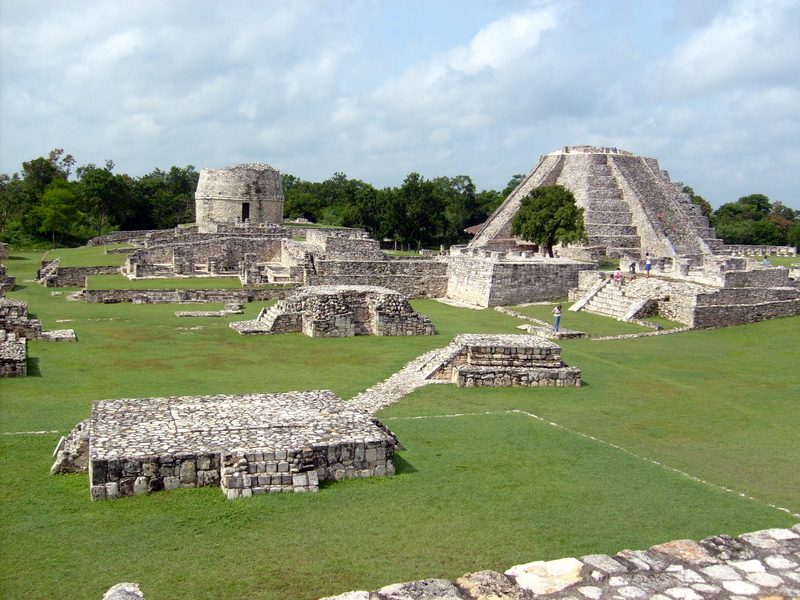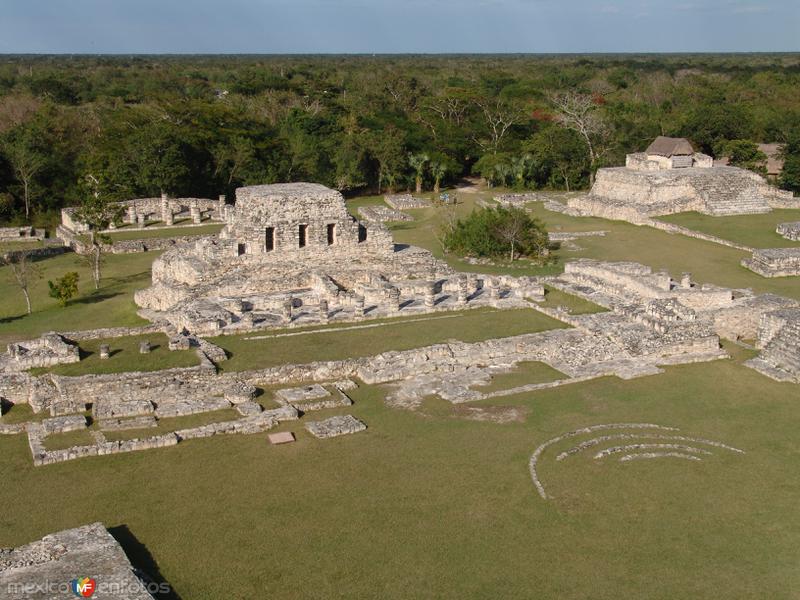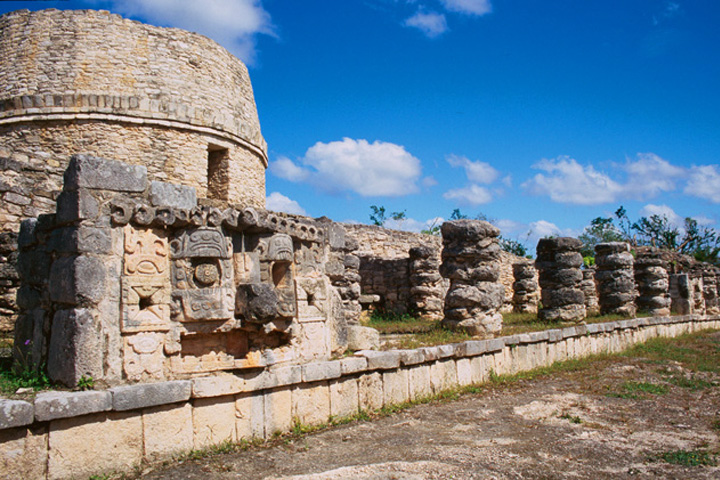Latin America
Related: About this forumArchaeologists Find Lid of Ancient Vault With Snake Symbol at Maya Palace
BY ARISTOS GEORGIOU ON 9/15/23 AT 3:11 PM EDT
Archaeologists in Mexico have uncovered an ancient Mayan artifact featuring a depiction of a serpent.
The stone block was used by the Maya as the cover of a vault, Mexico's National Institute of Anthropology and History said. Researchers found the stone artifact in the Acropolis, or royal palace, of Ek' Balam, an ancient Mayan city in the municipality of Temozón, Yucatán state.
The site was inhabited for more than a thousand years, thriving during the Late Classic period (A.D. 600 to 900), which marked the high point of Mayan culture.
The Mayan civilization dominated what is now southeastern Mexico, Guatemala, Belize and the western areas of El Salvador and Honduras for more than 3,000 years until the era of Spanish colonization.
The ancient Maya were notable for creating the only fully developed writing system in pre-Columbian America, their striking architecture and art, and their advanced calendar, mathematics and astronomical system.
More:
https://www.newsweek.com/archaeologists-find-lid-ancient-vault-snake-symbol-maya-palace-1827482
Judi Lynn
(164,041 posts)MND Staff
September 14, 2023
![]()
The ancient Maya city of Ek' Balam is one of the Yucatán's hidden gems. (INAH)
The quest to uncover the mysteries of Ek’ Balam — an ancient Maya city that includes one of the largest palaces in Mesoamerica — has been boosted by the discovery of a painted crypt cover.
The finding was announced this week in conjunction with a report on the progress of the Maya Train in Section 4, which spans 239 kilometers (149 miles) from Cancún Airport in Quintana Roo to Izamal, Yucatán.
![]()
Ek' Balam crypt
The crypt cover appears to show a snake descending into the underworld. (INAH)
The archaeological zones of Ek’ Balam (about 2 hours from Cancún) and Chichén Itzá (2 hours, 30 minutes) are the two ancient Maya sites that are part of the Section 4 project. Both are in the state of Yucatán.
The less-visited Ek’ Balam includes an awe-inspiring acropolis, or royal palace, in which more than 70 rooms have been found – and that’s just half the building. The site also has a mausoleum facade that is unique in the region.
Now, in yet another major archaeological finding associated with the Maya Train project, a seventh painted crypt cover has been recovered there.
These painted covers and similar artifacts “have provided relevant data about Ek’ Balam, such as names of some of the rulers of the kingdom of Talol (Ek’ Balam), as well as dates on which the rooms of the acropolis were built,” said Diego Prieto Hernández, general director of the National Institute of Anthropology and History (INAH).
![]()
The ancient city is known for its sprawling acropolis, which is still being excavated. (Adam Jones/Wikimedia)
At a press briefing on Monday in Mexico City, Prieto Hernández said that the stone slab cover is painted with a snake figure. Unlike other vault lids found at Ek’ Balam, this one has traces of red paint rather than black, INAH noted.
More:
https://mexiconewsdaily.com/culture/new-discovery-announced-at-ek-balam-site-in-yucatan/
Judi Lynn
(164,041 posts)
The walled city of Mayapán, known as "Flag of the Mayans", is considered the last great Mayan capital. It has an area of 4 km2, in which there are approximately 4,000 structures.
Its beginnings date back to the beginning of our era, reaching its maximum splendor in the Postclassic Period (1200 - 1450 AD). It is believed that this city had a population of 12,000 inhabitants. It was founded by the cocom group, whom experts associate with the bearers of the so-called Mayan-Toltec culture. It was the headquarters of "The League of Mayapán", a confederation that brought together the chiefs of Uxmal and Chichén Itzá. The disputes for control ended with the defeat of the Itzáes, who governed the region, and their flight was towards the Petén, where they founded the city of Tayasal. The hegemony of the League was exercised from that moment (end of the 13th century) by the cocomes of Mayapán, although with strong opposition from the inhabitants of the other Mayan kingdoms of the Peninsula. This alliance seems to have been dissolved around the year 1440,
Worthy of admiration is the work of its expert sculptors, which is distinguished by its large number of pieces of modeled stucco, which reflects the high quality of their works. It is worth highlighting the mural paintings in which war scenes and events related to the cult of death are captured, which makes evident its cultural links with the Altiplano of Central Mexico.
The city of Mayapán was built in the likeness of Chichén Itzá. Its main buildings are a copy of the capital of the Itzáes. The construction style incorporated elements typical of the architecture of Central Mexico, combined with features inherited from the ancient Mayan cities. However, with the fall of Chichén, Mayapán developed its own style oriented towards the reworking of ancient forms. Its main building is called El Castillo, being a pyramidal basement of 9 bodies with a height of 15 meters, where an interesting phenomenon of light and shadow takes place during the winter solstice (December 21), identical to that of Chichén Itzá .
You can also see civic, administrative and religious buildings, as well as the residences of the ruling class. These are buildings built on foundations that have corridors with columns, temples and oratories with an altar at the back and benches on the sides. The round buildings known as Observatories and the small sanctuaries are also representative.
https://www.yucatan.gob.mx/?p=mayapan






Judi Lynn
(164,041 posts)AncientPages.com | September 16, 2023 |

A Painted Vault Lid Discovered In Royal Palace Of Ek’ Balam Will Shed Light On History Of The Acropolis Of Ek’
AncientPages.com | September 16, 2023 | Archaeology, News
Conny Waters - AncientPages.com - Archaeologists in Mexico have discovered a painted ancient vault lid, decorated with a depiction of a serpent.
The Ministry of Culture of the Government of Mexico, through the National Institute of Anthropology and History (INAH), registered this unpublished mural painting on the stone artifact.
Ek' Balam is a Yucatec-Maya archaeological site within the municipality of Temozón, Yucatán, Mexico. It lies in the Northern Maya lowlands, 25 kilometers (16 mi) north of Valladolid and 56 kilometers (35 mi) northeast of Chichen Itza. The place was particularly important place from the Preclassic until the Postclassic period. During this time, it played an essential role as the seat of a Mayan kingdom.
The site is noted for preserving the plaster on the tomb of Ukit Kan Lek Tok', the most important ruler of the Maya city of Ek Balam during the Late Classic period (A.D. 600 to 900), buried on the side of the largest pyramid.
Archaeologists also informed that this discovery of the stone block - used by the ancient Mayans as a vault lid, in one of the structures of the Ek’ Balam Acropolis - will play a crucial role in deciphering the history of the Ek’ Balam Acropolis.
This block is the seventh painted vault lid unearthed in the last year in this archaeological zone of excavations of Yucatan.
More:
https://www.ancientpages.com/2023/09/16/a-painted-vault-lid-discovered/
Over the years, we've read articles on general screwing around by stupid tourists swarming over the earlier ancient Aztec and Mayan structures. The destructiveness of idiots touring the sites has already left a trail, and created deep resentment among citizens. The thought of a tsunami of loud, pushy, self-centered people from the States galloping up and down ancient crumbling staircases, even when there are signs telling them to stay off the stairs, doesn't leave you feeling too optimistic for the future of the Yucatán. Just making a ton of tourism bucks for the Mexican treasury would never justify losing priceless historical buildings and monuments.
Sure hope this has all been foreseen and dealt with before they unleash the hordes upon these super-old communities. It would be better if they had never bothered to open it up in the first place.